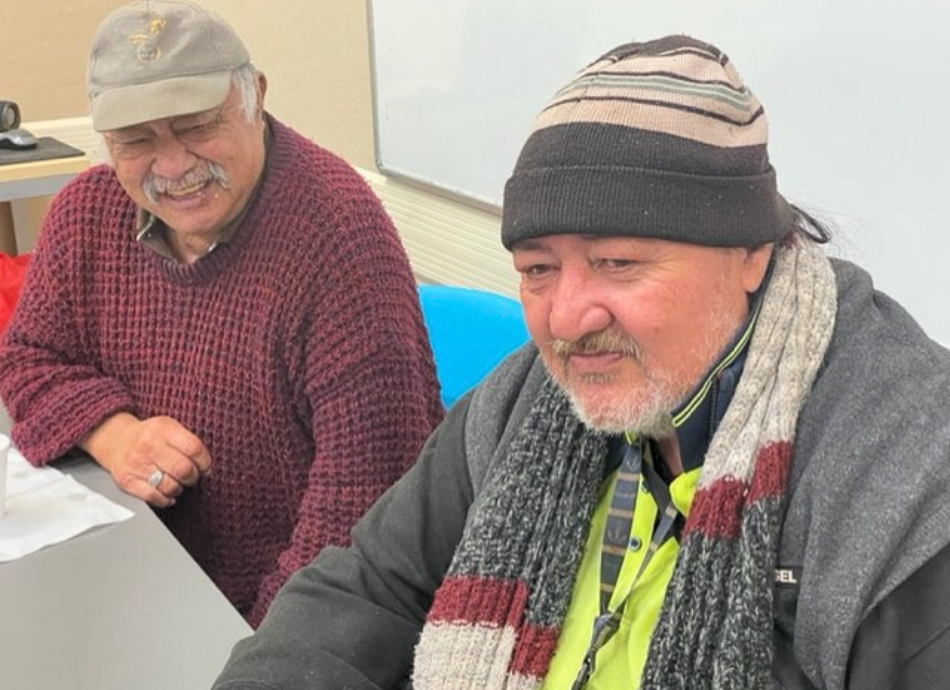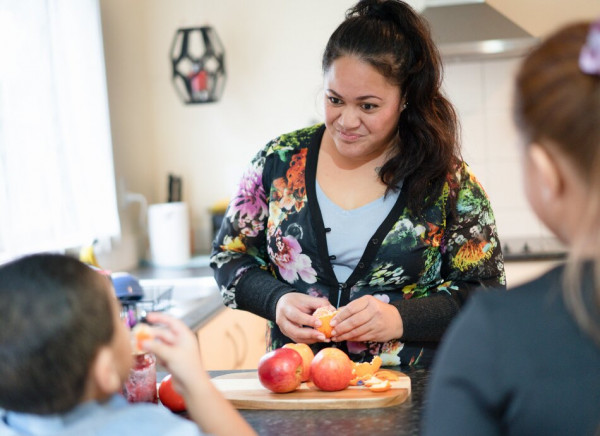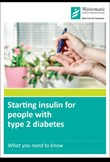Diabetes – type 2 overview
Previously known as non-insulin dependent diabetes or adult-onset diabetes
Key points about type 2 diabetes
- Type 2 diabetes (mate huka momo tuarua) is a condition where your body can't control its blood glucose (a type of sugar) levels properly. This can lead to a wide range of health problems if not treated.
- Type 2 diabetes is common, but many people don't know they have it.
- Most (80%) of type 2 diabetes can be prevented by keeping to a healthy body weight, eating healthy foods and keeping physically active.
- If you have diabetes, see your healthcare provider every 3 months or more for regular check-ups, not just when something is wrong.
- Attending a diabetes self-management course can help you to live well with diabetes.

Diabetes is a condition where the level of glucose (a type of sugar) in your blood is too high. The amount of glucose in your blood is controlled by several different hormones, but the main one is insulin. The organ that makes insulin is your pancreas. If you have type 2 diabetes, you have some damage to your pancreas and do not respond to insulin as well as people without diabetes.
Type 2 diabetes is a progressive disease, which means that, without appropriate treatment and lifestyle change, it slowly gets worse with time. This is because the cells that produce insulin in your pancreas continue to be damaged or die. Your body becomes even less able to make enough insulin to balance your blood glucose.
Can children have type 2 diabetes?
Type 2 diabetes can also occur in children. Most children with diabetes have type 1 diabetes, which is an auto-immune disease where your body attacks cells in your pancreas so that not enough insulin is produced. However, children who become overweight can develop type 2 diabetes. Usually there is a family history of diabetes and often these children belong to ethnic groups that are more likely to develop diabetes. Type 2 diabetes is more common in people of Māori, Pacific and South Asian descent.
Video: 1C Diabetes - Information for South East Asian families
This video may take a few moments to load.
Many people have type 2 diabetes for years without realising it, because they don’t have symptoms.
If you do get symptoms, these may include:
- feeling very thirsty/hiainu
- needing to pee/mimi a lot, especially at night
- feeling very tired
- blurred vision
- urinary infections or skin infections
- itching around your genitals or frequent episodes of thrush
- cuts and grazes healing slowly.
Video: 1a Diabetes - Overview & Symptoms
Videos: Diabetes series of 10 videos Healthify He Puna Waiora, NZ
Diabetes is diagnosed using a simple blood test called an HbA1c test. Your doctor will suggest testing for diabetes if you have symptoms that might be due to diabetes. If you are in the high-risk group for type 2 diabetes but don’t have symptoms, your doctor will also request an HbA1c test. Checking for diabetes when you have risk factors, but no symptoms, is known as ‘screening’.
Read more about what my HbA1c results mean.
You should be screened for diabetes if you:
- are over the age of 45 years (for men) or 55 (for women) – this is part of routine testing for heart and blood vessel disease
- are of Māori, Pacific Peoples or Indo-Asian ethnicity and over 30 years of age (men) or over 40 years (women)
- have been diagnosed with prediabetes
- have had diabetes in any pregnancy (gestational diabetes)
- are overweight or obese and have at least 1 other risk factor for diabetes (eg, a close relative with type 2 diabetes, smoking, high blood pressure or heart disease).
If this applies to you, it's recommended that you get checked for type 2 diabetes (or prediabetes), even if you don't have symptoms. It’s easy to test for diabetes and it's important to find out, so you can take steps to prevent diabetes-related health problems.
Diabetes increases the risk of many serious conditions such as poor vision, heart disease or stroke, damage to your kidneys (diabetes is the top cause of kidney failure), erectile dysfunction and loss of limbs.
The best way to avoid or delay developing diabetes-related health problems is by keeping your blood glucose and blood pressure levels within the healthy range. You can do this by following the advice on managing type 2 diabetes below, which includes lifestyle changes and medicines.
Read more about how blood glucose control is measured.

Image credit: Canva
The treatment goal for type 2 diabetes is to keep your blood glucose levels within the healthy range as much as possible. Type 2 diabetes is a condition that can be improved by changes in your lifestyle. These changes also help you if you have high blood pressure or too much fat or cholesterol in your bloodstream.
Your doctor will suggest you make changes to your lifestyle first. If these changes work, you may not need to take medication, but even if you do need medicines, you should still try hard to have a healthy lifestyle.
Healthy lifestyle to improve blood glucose control and heart health
- Weight reduction – losing weight is an important target for most people with type 2 diabetes. Most people lose weight when they have a healthier diet and increase physical activity. You may also want to consider a weight loss programme. A good goal is to aim to lose 5–10% of your bodyweight. So if you weigh 100kgs, this means losing 5–10kgs.
- Healthy eating – this means eating plenty of vegetables and fresh fruit, whole grains, lean meat, fish and eggs, in the right portions. Cut back on junk food, takeaways and fizzy drinks. If you can, talk to a registered dietitian to get the best advice.
- Increase physical activity – aim for 30 minutes of moderate-intensity physical activity, such as brisk walking, on most days. You may start with ‘snacks’ of activity – 3 x 10 minutes daily. Even if you can't reach these levels, any increase in activity will bring benefits in diabetes control and overall health.
- Healthy sleep – getting 6–8 hours sleep every night can help control your blood glucose and body weight. If you have difficulty with sleep, talk to your healthcare provider or check out our sleep resources.
- Healthy heart – you are at greater risk of heart disease if you have diabetes. A healthy lifestyle and quitting smoking also help with blood pressure and cholesterol control.
Read more about self-care with diabetes.
Medicines for type 2 diabetes
Diabetes medications are started when lifestyle changes on their own haven't been enough to keep your blood glucose to health levels. Sometimes, medicines may be prescribed at diagnosis if blood glucose levels are very high. Diabetes medicine doesn't replace lifestyle changes – it's used in addition to eating a healthy balanced diet, weight loss and regular exercise.
There are a variety of medicines used to treat type 2 diabetes – most are available as tablets. The most commonly prescribed medicine is metformin. Some people also need insulin, which is available as an injection only.
Your diabetes may be well controlled on 1 medicine alone, or you may need a combination of medicines, including a combination of tablets and insulin injections. Every person’s care plan is different and your healthcare provider will work with you to find the best treatment plan for you.
Read more about diabetes medications.
Do I need insulin?
Insulin injections are needed if your body stops producing enough insulin. With time, many people with type 2 diabetes need to use insulin injections.
- The insulin you inject is manufactured in a laboratory. It's made to mimic the action of insulin that occurs naturally in your body. It is a very safe product to take.
- Insulin is injected just under your skin, not in a vein.
The common ways of using insulin for type 2 diabetes include:
- once a day – often at bedtime
- 2 times a day – morning and evening.
Read our page on starting insulin and see the booklet Starting insulin in type 2 diabetes(external link) (Waitematā DHB) available in 5 languages including Samoan and Tongan. There are links below.
Apps reviewed by Healthify
You may find it useful to look at some Diabetes apps.
There are many groups and people keen to share their knowledge and tips for living well with diabetes. Diabetes NZ(external link) has branches around the country with a wide range of services, resources, groups and shops.
Regional diabetes support
- Diabetes NZ(external link) – all branches
- Diabetes Auckland(external link)
- MHT Diabetes Trust (Manawatu, Horowhenua, Tararua)(external link) Phone 06 357 5992. Offers education courses, youth & family support, support groups and more.
- Diabetes Wellington(external link)
- Diabetes Christchurch(external link)
You also find more support options on the diabetes support page.
Diabetes self-management education for people with type 2 diabetes
- What it is: A range of courses covering basics about diabetes.
- Who it's run by: Multiple organisations including local Primary Health Organisations, District Health Boards, and community organisations such as Diabetes NZ and Diabetes Auckland.
- Who it's for: People with type 2 diabetes and their whānau.
- Contact details: Ask your healthcare provider about what's available in your area or you can contact the organisations yourself.
Regional information
Auckland District Health Board region
- Auckland PHO(external link) provide diabetes self-management classes for central Auckland from Avondale to Panmure and city to Hillsborough. Phone: 09 379 4022. Contact Auckland PHO for the latest timetable of courses
Waitemata DHB region
- Comprehensive Care(external link) provides free diabetes self-management education classes in Albany, Orewa, Stanmore Bay, Ranui, Henderson and Birkdale. Phone: 09 448 0019, or contact via email: [email protected].
Counties Manukau – most areas covered – check with your GP.
- East Health(external link) have a range of programmes including diabetes, weight management and more. [email protected]
- ProCare Health Contact Self-Management Team via email: [email protected] or Ph: 09 3547770, or call or text 0275358250. (No cost to practice, patient or carer)
Auckland wide
- ProCare Health has a range of self-management programmes running across wider Auckland and anyone is welcome. Contact via email: [email protected] or Ph: 09 3547770. Call or text 0273395740
Western Bay of Plenty
- The Western Bay of Plenty Primary Health Organisation(external link) runs self-management groups for the community across Tauranga and surrounding areas on the topics of type 2 diabetes and lifestyle wellness. Contact [email protected] for more information or call (07) 571 7729.
Nelson/Marlborough
Nelson Bays Primary Health(external link) and Marlborough Primary Health. Alternatively you could contact Health New Zealand |Te Whatu Ora Nelson Marlborough(external link) and ask about diabetes programmes.
MidCentral District Health Board region – Diabetes Trust(external link) provide diabetes self-management education classes for the Palmerston North region. Phone: 06 357 5992, or use their contact email address(external link). Details of the courses can be found on the Diabetes Trust(external link) page.
Other regions
- Check with your healthcare provider or let us know.
These videos may take a few moments to load.
Annette's dialysis story
Annette is one of over 200,000 New Zealanders with type two diabetes. Sadly, she ignored the warning signs and now is experiencing severe consequences, she depends on a dialysis machine to do the work of her kidneys. Annette's story is presented in English and te reo Māori.
Video: WOF4 Episode 1 - Dialysis Part 1 of 3
Video: WOF4 Episode 1 - Dialysis Part 2 of 3
Video: WOF4 Episode 1 - Dialysis Part 3 of 3
(Faultline Films NZ, 2010)
Lisa's type 2 diabetes story
Lisa Clayton Kāi Tahu/Rangitāne is one of over 200,000 New Zealanders who know they have type 2 diabetes. It's estimated that another 100,000 people have the disease without knowing it. If Lisa is going to avoid some nasty complications she needs to take action now (this video is mostly spoken in Māori).
Video: WOF3 Episode 3 - Type 2 Diabetes Part 1 of 3
Video: WOF3 Episode 3 - Type 2 Diabetes Part 2 of 3
Video: WOF3 Episode 3 - Type 2 Diabetes Part 3 of 3
(Faultline Productions & Te Māngai Pāho, NZ, 2010)
Video: The disease that is killing my family: Part 1
(Attitude Live, NZ)
Video: The disease that is killing my family: Part 2
Brian Kairau can't feel his feet. Years of type 2 diabetes has damaged the small blood vessels leaving him vulnerable to infection. Will doctors be able to save his foot from amputation?
(Attitude Live, NZ)
Video: The disease that is killing my family: Part 3
At 52, former gang leader turned youth worker Brian Kairau has one more dream left: riding a Harley.
(Attitude Live, NZ)
To view more videos of the same series, visit Attitude Live: The disease that is killing my family(external link) (Attitude Live, NZ) presented in English.
Diabetes topics
What is diabetes?
Prediabetes | Tūraru mate huka
Home blood glucose testing for type 2 diabetes
Glycaemic index (GI)
Medicines for type 2 diabetes
Driving with diabetes
Diabetes and eye problems
Diabetes self-management programmes
Diabetic foot ulcer
Low blood glucose (hypoglycaemia)
Diabetic neuropathy (nerve damage)
Sick day plan for people with type 2 diabetes
Diabetes and smoking
Diabetes and Ramadan
Learn more
Diabetes NZ(external link)
Diabetes UK(external link)
Group education
To find out what diabetes education is available in your region, ask your local branch of Diabetes NZ, other regional support organisation or your healthcare provider.
Resources
Brochures
- Diabetes type 2 brochure [PDF, 542 KB] Healthify He Puna Waiora and Mediboard, 2023 English [PDF, 542 KB], te reo Māori [PDF, 544 KB], Samoan [PDF, 535 KB], Tongan [PDF, 563 KB], Chinese (simplified) [PDF, 836 KB], Chinese (traditional) [PDF, 945 KB], Cook Islands Māori [PDF, 517 KB], Hindi [PDF, 1.9 MB], Niuean [PDF, 483 KB], Tuvaluan [PDF, 501 KB]
- Diabetes – a risk factor for heart attack and stroke(external link) Heart Foundation, NZ, 2019 English(external link), te reo Māori(external link), Chinese(external link), Korean(external link), Samoan(external link), Tongan(external link), Order resources(external link)
- Starting insulin for people with type 2 diabetes(external link) SafeRx, Waitematā DHB, NZ Chinese(external link), English(external link), Korean(external link), Samoan(external link), Tongan(external link)
- Staying well with type 2 diabetes Diabetes NZ, 2015 English [PDF, 2.1 MB], Chinese [PDF, 1.4 MB], Hindi(external link)
- Type 2 diabetes factsheet 2011 [PDF, 537 KB] Diabetes NZ, 2011 Arabic [PDF, 1.1 MB], Chinese [PDF, 1.2 MB], English [PDF, 537 KB], Hindi(external link), Korean [PDF, 1.2 MB], te reo Māori [PDF, 2.5 MB], Samoan [PDF, 1.2 MB], Tongan [PDF, 1.2 MB], Vietnamese [PDF, 1.2 MB]
- Type 2 diabetes – self-monitoring of blood glucose(external link) Choosing Wisely, NZ, 2016 [PDF, 207 KB]
- Empagliflozin factsheet [PDF, 207 KB] Healthify He Puna Waiora, NZ, 2025 English [PDF, 207 KB], Te reo Māori [PDF, 683 KB], Samoan [PDF, 663 KB], Tongan [PDF, 794 KB], Chinese (simplified) [PDF, 772 KB]
- Diabetes during Ramadan(external link) WellShare International, 2013
- Diabetes and how to care for your feet(external link) Diabetes NZ
- Diabetes bilingual brochures in multiple languages(external link) Health Information Translations, MedLine Plus, US
Apps/tools
References
- Understanding type 2 diabetes(external link) Diabetes NZ
- Type 2 diabetes management guidance(external link) NZSSD, NZ
- A rising tide of type 2 diabetes in younger people – what can primary care do?(external link) BPAC, NZ, 2021
- Screening for diabetes in asymptomatic adults(external link) NZSSD, NZ
- Complications of diabetes(external link) Diabetes NZ
- Clinical guidelines for weight management in New Zealand adults(external link) MOH, NZ, 2017
- Healthy eating and weight loss(external link) NZSSD, NZ
- Physical activity(external link) NZSSD, NZ
- Sleep(external link) NZSSD, NZ
Brochures

Healthify He Puna Waiora, NZ and Mediboard, 2023
English, te reo Māori, Samoan, Tongan, Chinese (simplified), Chinese (traditional), Cook Islands Māori, Hindi, Niuean, TuvaluanCredits: Healthify editorial team. Healthify is brought to you by Health Navigator Charitable Trust.
Reviewed by: Claire Salter, Pharmacist, Tauranga.
Last reviewed:






